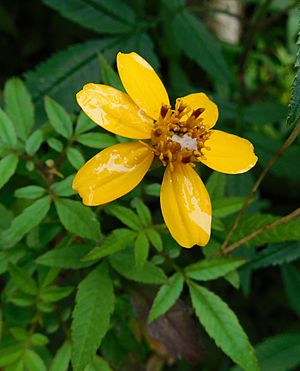Tagetes nelsonii facts for kids
Quick facts for kids Tagetes nelsonii |
|
|---|---|
 |
|
| Scientific classification | |
| Genus: |
Tagetes
|
| Species: |
nelsonii
|
| Synonyms | |
|
|
The Tagetes nelsonii is a special type of marigold flower. It belongs to the Asteraceae family, which is a big group of flowering plants like daisies and sunflowers. This plant is originally from Guatemala and the southern part of Mexico, specifically a state called Chiapas.
Contents
About Nelson's Marigold
Nelson's Marigold is a fascinating plant known for its unique features. It's often called the citrus-scented marigold because of its fresh, zesty smell. This plant is not just pretty; it's also known to be an edible flower, meaning you can eat it! People often enjoy it raw, adding a special flavor to their meals.
What Does Nelson's Marigold Look Like?
This marigold is an annual herb, which means it grows from a seed, flowers, produces seeds, and then dies all within one year. It doesn't have any hairs on its stems or leaves, making it feel smooth.
It can grow quite tall, from about 50 centimeters (20 inches) up to 2 meters (6 feet)! Imagine a plant taller than most kids your age. Its leaves are interesting too; they are "pinnately compound." This means each leaf is made up of smaller leaflets, usually 3 to 7 of them, arranged along a central stem like feathers.
The Flowers of Nelson's Marigold
The plant produces many small flower heads. These flower heads grow together in a flat-topped cluster, making them easy to spot. Each little flower head is packed with color.
Inside each flower head, you'll find two types of tiny flowers:
- Ray florets: These are the petal-like flowers around the edge. Nelson's Marigold usually has 5 to 6 bright yellow ray florets.
- Disc florets: These are the small, tube-shaped flowers in the center. There are typically 9 to 12 greenish-yellow disc florets in each flower head.
Where Does Nelson's Marigold Grow?
This marigold is native to specific regions in Central America. You can find it growing naturally in:
- Guatemala: A country in Central America known for its rich plant life.
- Chiapas, Mexico: A state in southern Mexico that has diverse ecosystems, from mountains to rainforests.
It thrives in these areas, adding beauty and a citrusy scent to the local environment.
Images for kids
See also
 In Spanish: Tagetes nelsonii para niños
In Spanish: Tagetes nelsonii para niños


